ECOLOGICAL RESTORATION ON BALTRA
Ecological restoration on Baltra Island: development of a method for the restoration of arid ecosystems applicable on a large scale
Baltra is an island with about 27 km 2 of surface and a relatively low altitude of 20-30 m.a.s.l. These characteristics mean that it is located in an area with extremely arid conditions (Snell et al., 1996), with vegetation adapted to this environment. In addition, Baltra has suffered a high degree of degradation as a consequence of anthropogenic actions: during World War II, it was used as a military base for the US army and, currently, it has the main airport of the archipelago that connects the Galapagos with continental Ecuador (D. J. Geist et al., 1985; Kenchington, 1989). . If the arid conditions together with the aforementioned human activity are taken into account, both are a major obstacle to an accelerated ecological restoration (D. Geist et al., 2002; Itow, 1992) and make Baltra one of the islands of the archipelago with the greatest ecological degradation. Added to this, the presence of introduced species, such as feral goats and cats, has caused major changes to the ecosystem and the populations of key endemic species, such as land iguanas and Opuntia cacti (Balseca Moscoso, 2002; Gibbs, 2013; Jaramillo et al., 2013; Sulloway & Noonan, 2015), even leading to the disappearance of the land iguana population in 1940. The repopulation of land iguanas and the eradication of feral goats represented the first step in the ecological restoration of Baltra (De Vries & Black, 1983; Phillips et al., 2005; Sulloway & Noonan, 2015).
These are the main reasons why the Galapagos Verde 2050 (GV2050) team began efforts to restore the flora on this island starting in 2013, beginning with two study sites near the airport: the Airport Garden and the Old Garbage Dump. Later, in Phase 2, these sites were reconsidered, and three study sites were selected according to the criteria of high ecological degradation: Stone House, Old Garbage Dump and Wind Farm, since these are areas with defined high-priority ecosystems by the GNPD. In addition, the GV2050 established an agreement with the Galapagos Ecological Airport (ECOGAL), which is also working to achieve ecological restoration.
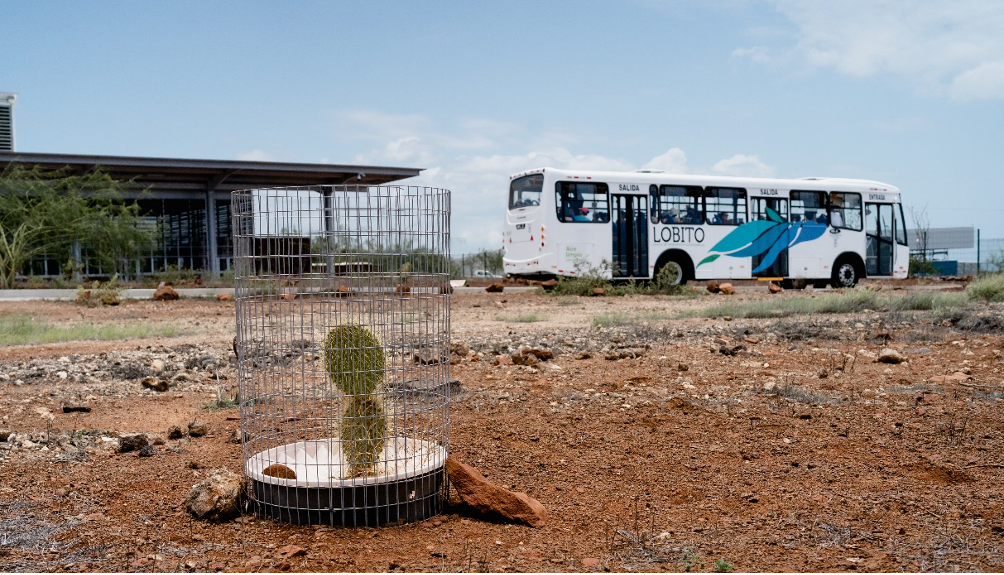
Opuntia planted with Waterboxx® technology next to the ECOGAL airport.
In 2021, the relatively undegraded North Seymour Island was used as a reference ecosystem to generate restoration targets for Baltra. To achieve this, the vegetation of woody species and cacti present on this island was evaluated, and a list of 15 priority species and their densities were generated as result. With all the information collected, the expansion of the project will be carried out under the "Baltra Verde 2050" subproject, which hopes to contribute to the conservation of the island through the development of a general method of restoration of arid ecosystems applicable to a large scale in sites with different uses. This subproject plans to restore five hectares as a model for the future restoration of the rest of the island.
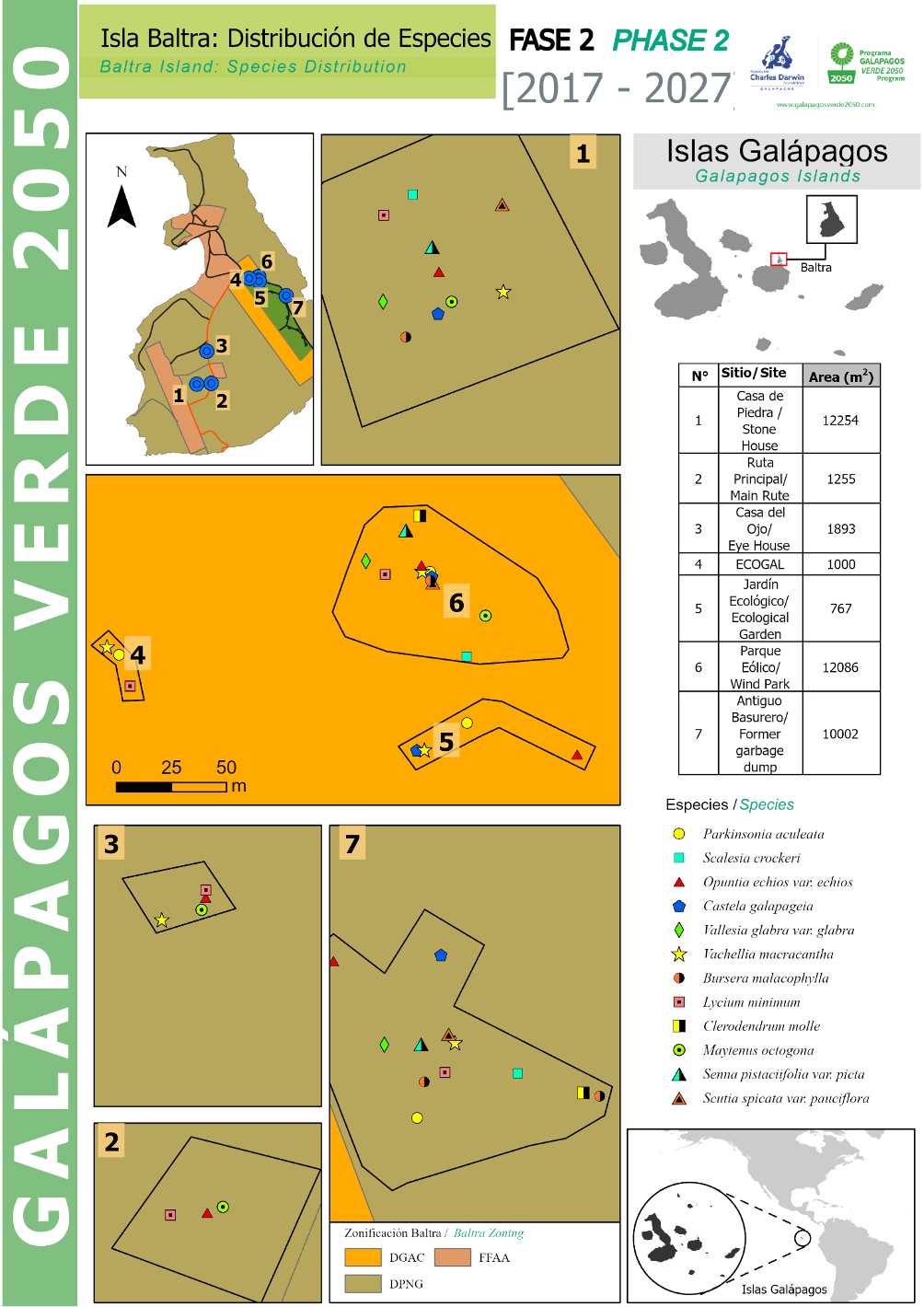
The geographical location of study sites and seedling species on Baltra Island. Produced by: Cárdenas D. 2022
Timeline
The GV2050 was born in 2013 as a single project with two components: ecological restoration and sustainable agriculture; remaining with this scheme until 2021, when it takes the category of Program made up of 7 different projects. Baltra is one of the three islands, along with Floreana and Santa Cruz, with which the current program began to work in the Pilot Project. Since Phase 1, it has undergone modifications due to the results obtained with water-saving technologies, among others. Like the other projects, it is scheduled to end in 2050, but in disagreement with the other projects, it has been considered a special subproject called "Baltra Verde 2050".
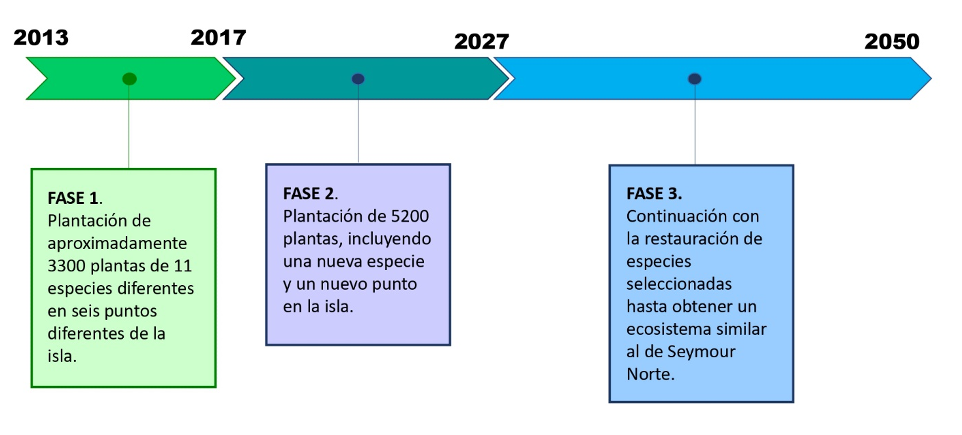
The phases of Ecological Restoration on Baltra project.
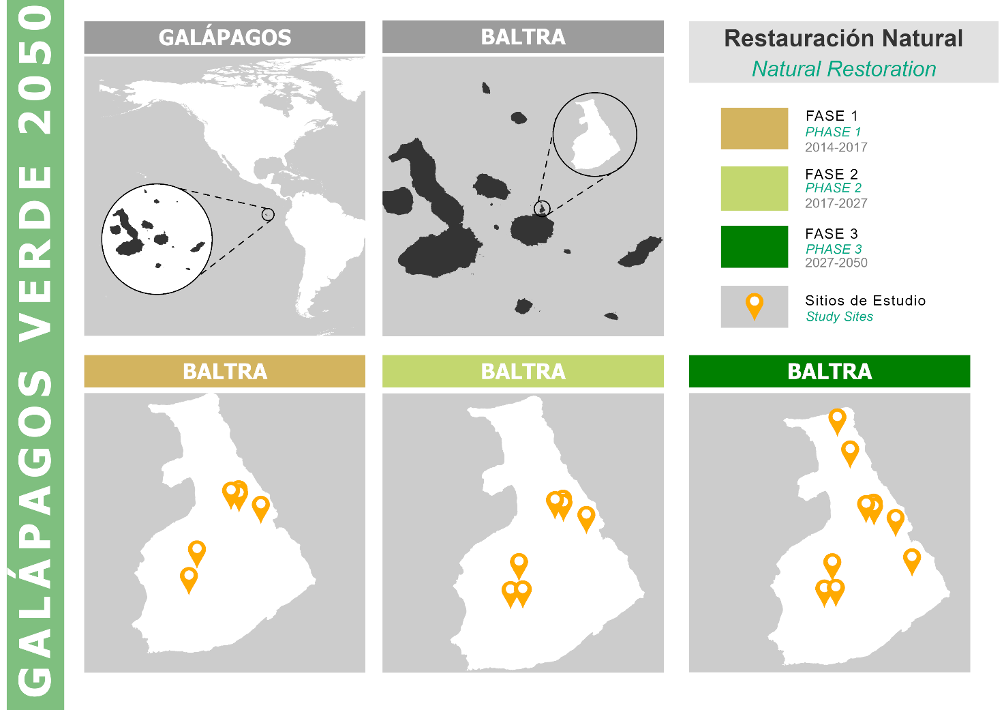
Map of the phases of the Ecological Restoration project on Baltra Island. Produced by: Cárdenas D. 2022
Results so far
Currently, the project covers an area of three hectares which covers three study areas. Through successive restoration actions, the GV2050 will create a network of corridors with endemic and native plant species in these areas zonas (Jaramillo et al., 2017). In addition, the project collaborates with the ECOGAL Airport, where an ecological corridor has been established to deter land iguanas from crossing through the airport runway, and ecological gardens that sustain more than 200 endemic plants of Baltra.
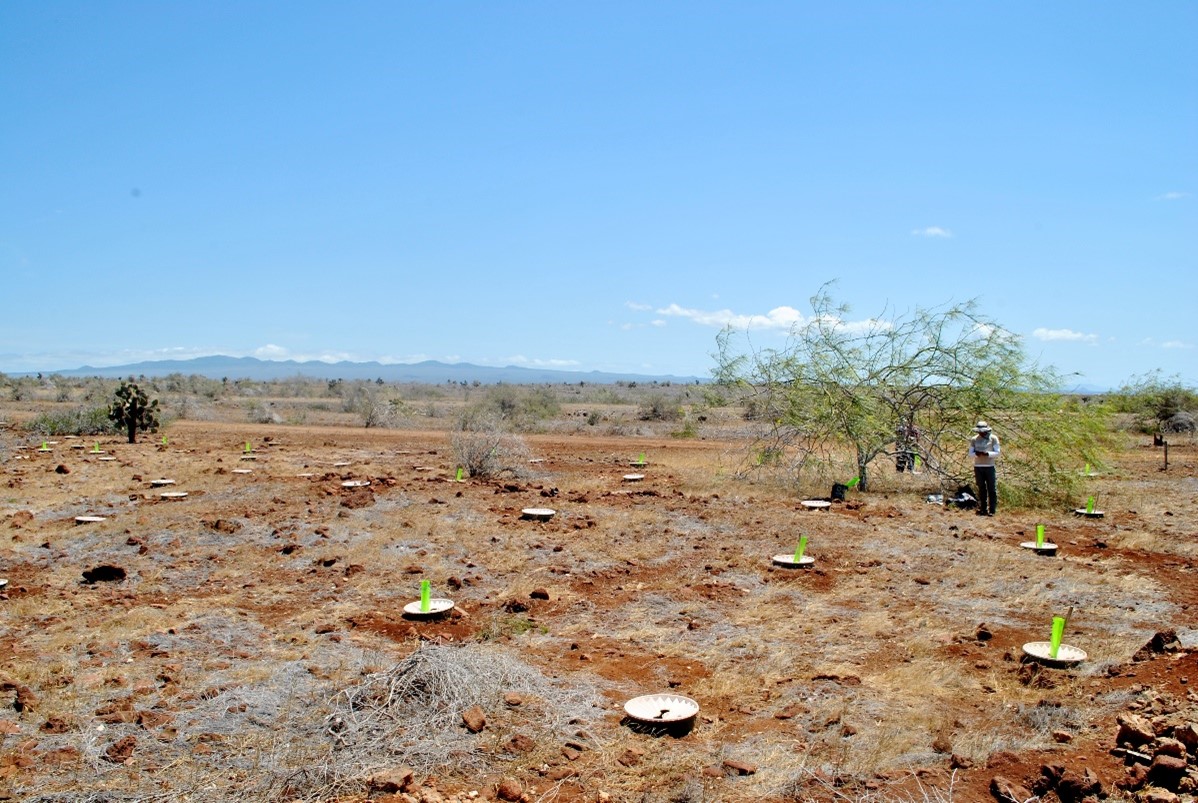
The GV2050 team working on the garbage dump on Baltra Island.
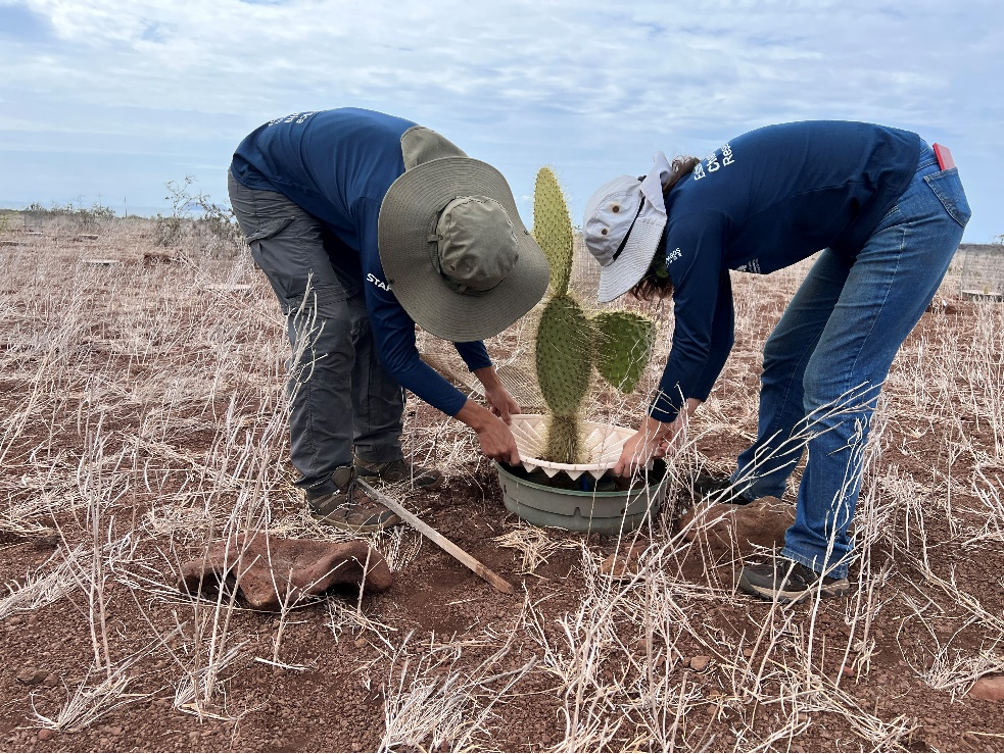
Activities carried out in the Stone House, Baltra Island.
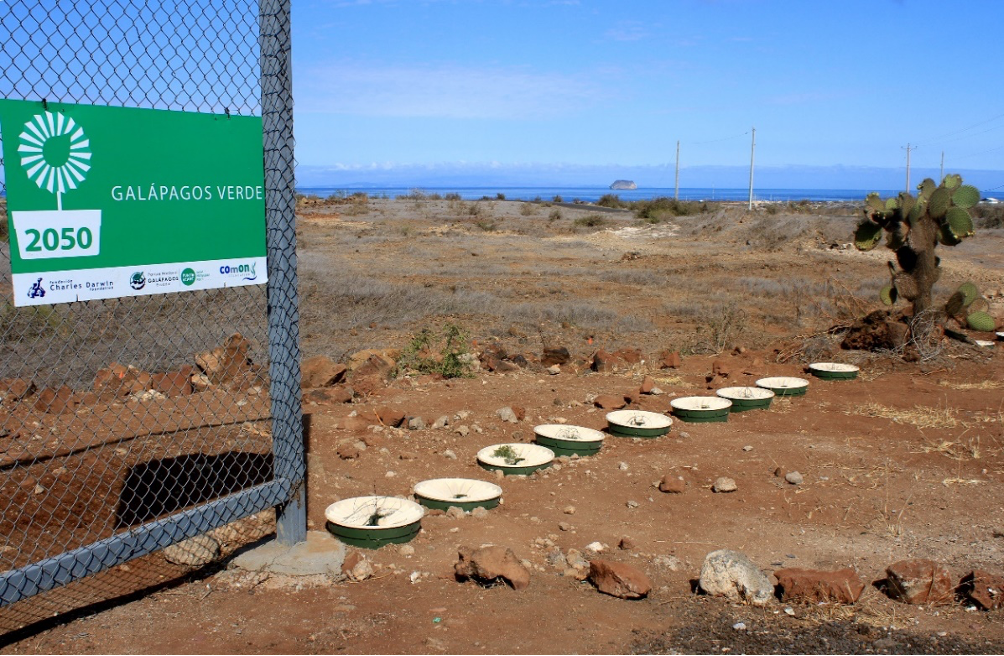
Ecological corridor in the ECOGAL airport, on Baltra island.
So far, we have planted over 6,000 plants of 12 native and endemic species to restore Baltra. The results of Phase 1 have allowed us to understand the effectiveness of the different water-saving technologies, which has helped to modify the scheduled planting in Phase 2 to achieve a much faster and more effective restoration. Preliminary results from Phase 1 indicated that Opuntia echios var. echios planted with Groasis grow faster than controls planted without Groasis; it is known that this species grows around two centimetres per year under natural conditions. Therefore, Groasis increased the growth rate by more than double that of the natural one without technology (Coronel, 2000; Estupiñán & Mauchamp, 1995; Hicks & Mauchamp, 2000). In the opposite case, the Cocoon technology only favoured the survival of Vachellia macracantha among all the species with which it was planted in Baltra.
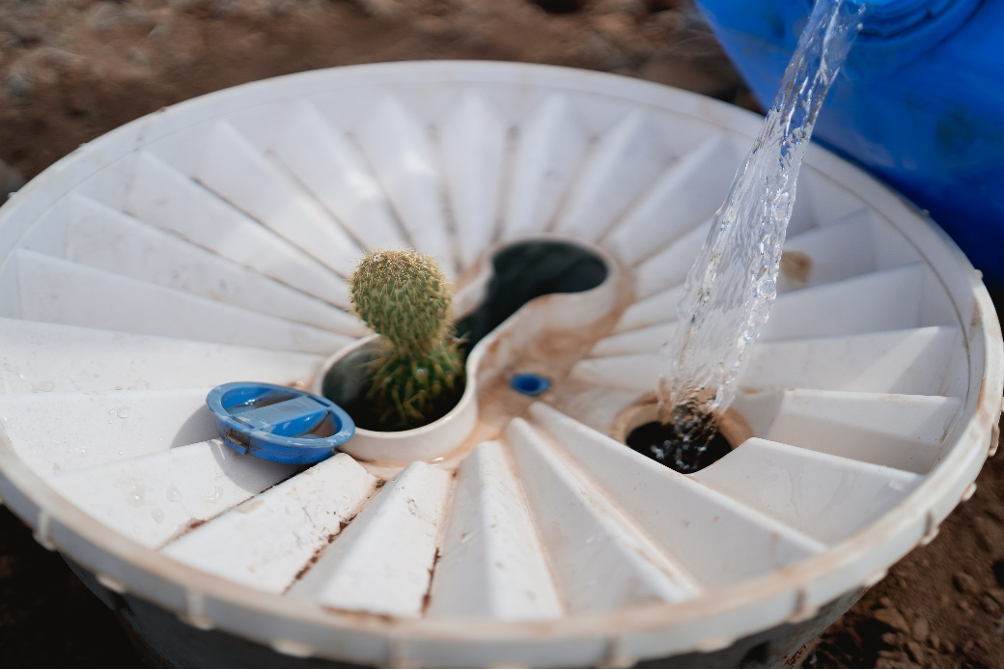
Opuntia with Groasis technology.
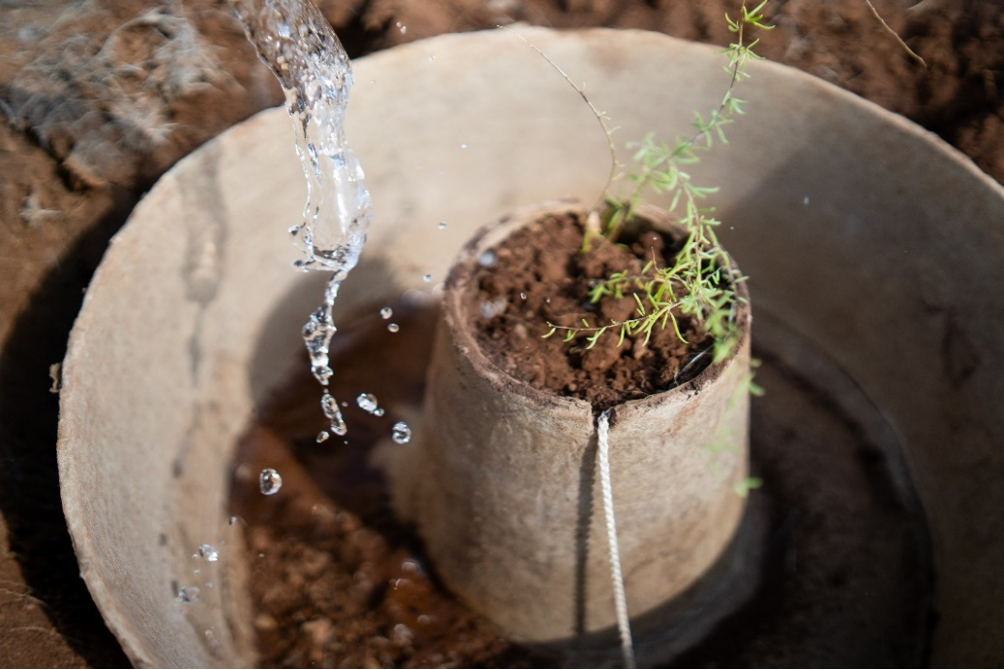
Lycium minimun with Cocoon technology.
Until the last monitoring, in August 2022, 6,400 individuals of 12 species were planted. This activity was carried out in eight study sites in Baltra. The analysis of the data collected in the field reveals that the effectiveness of water-saving technologies varies according to the species. In certain conditions, the survival rate and growth of seedlings can increase however, in three cases, depending on the species and climatic conditions, the effect could be the opposite.
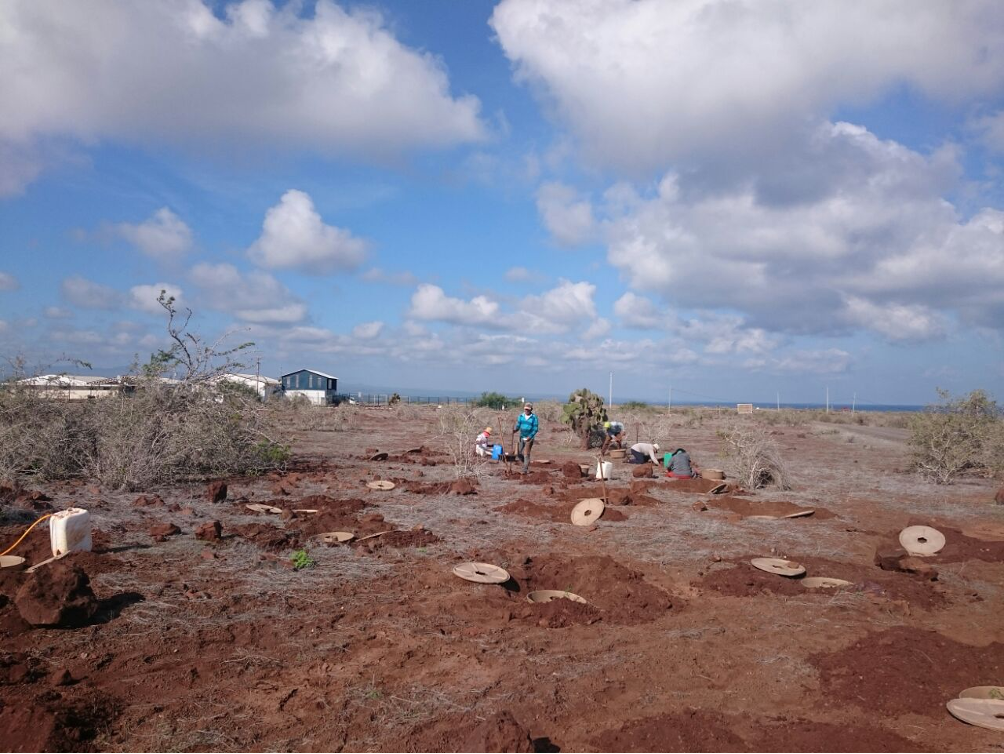
Planting activities under the arid conditions of Baltra Island.
¿Can you guess how many plants have we put on Baltra?
GV2050 began with ecological restoration in Baltra since its inception in 2013, as part of its Pilot Program. From then until August 2022, 6,412 plants have been planted, of which 2,365 individuals have survived. The survival rate is 37%.
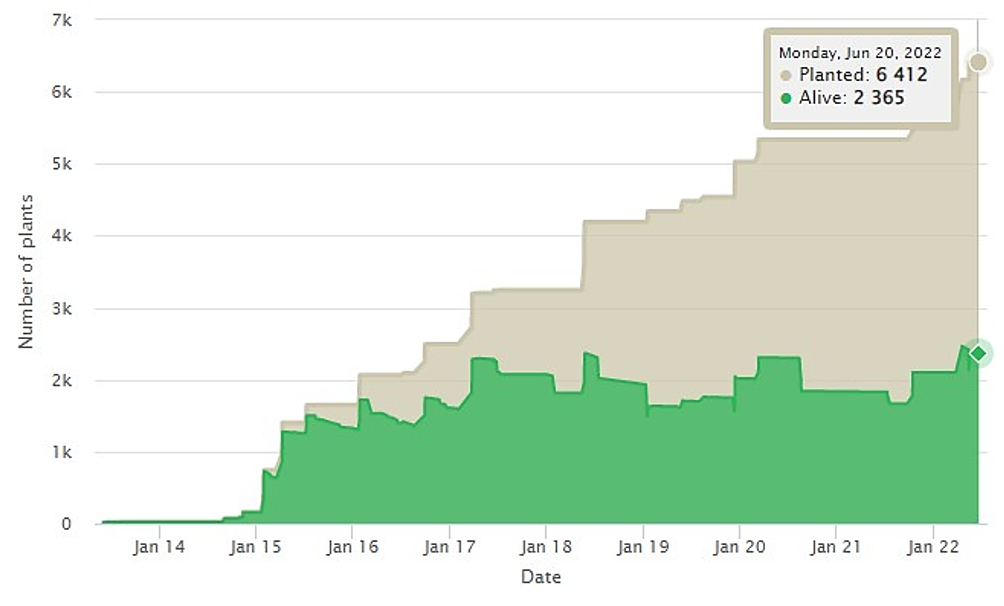
Representative graph of all species planted in Baltra. In grey, all the planted individuals; in green, the living species. Source: RestoR GV2050. Capture date: October 2022
As previously explained, the restoration in Baltra has provided much information about water-saving technologies and the species in which they are used. According to the following graph, the technology with the highest probability of survival is the Waterboxx®, which shows a 25% survival rate approximately 90 months after planting. It is followed by the combination of Waterboxx® + Hydrogel technologies, having an approx. 10% survival in the 60th month of its plantation. Hydrogel and the combination of Cocoon + Hydrogel only last up to 36-40 months, approximately. Finally, there is the Cocoon technology, which reaches 0% survival in approximately 36 months.
On the other hand, the control reaches a 0% survival at month 90, approximately, which means that, compared to other treatments, such as Hydrogel and Cocoon, it has better efficacy; that is, for these control plants, it is a better method not to have any saving technology than to be planted with Hydrogel or Cocoon.
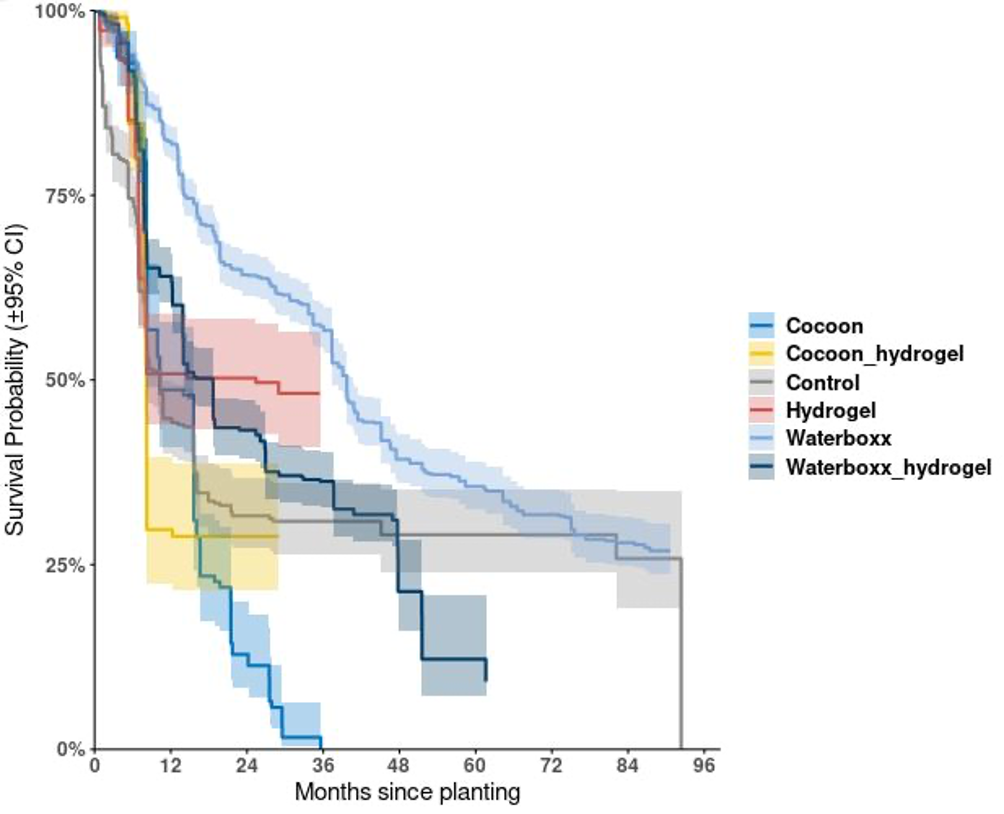
Representative graph of the survival percentage according to the different water-saving technologies. Source: RestoR GV2050. Capture date: October 2022
The previous results coincide with the predictions that were expected for the water-saving technologies since if the graphs are observed, the Waterboxx®, Waterboxx® + Hydrogel technologies and the control are the ones that present a lower error bar, which means that will be the conditions with the best results. On the contrary, the Cocoon, Hydrogel and Cocoon + Hydrogel technologies present the highest error bars, meaning they are the technologies with the lowest survival percentages.

Representative graph of the expected survival percentage according to the applied water-saving technology. Source: RestoR GV2050.
¿ Do you want to know a little more about our project in Baltra?
You can also find our news on social networks:
Puedes descargar más información de algunas de nuestras publicaciones
Descargar libro "Galápagos Verde 2050 (Volumen 1)"
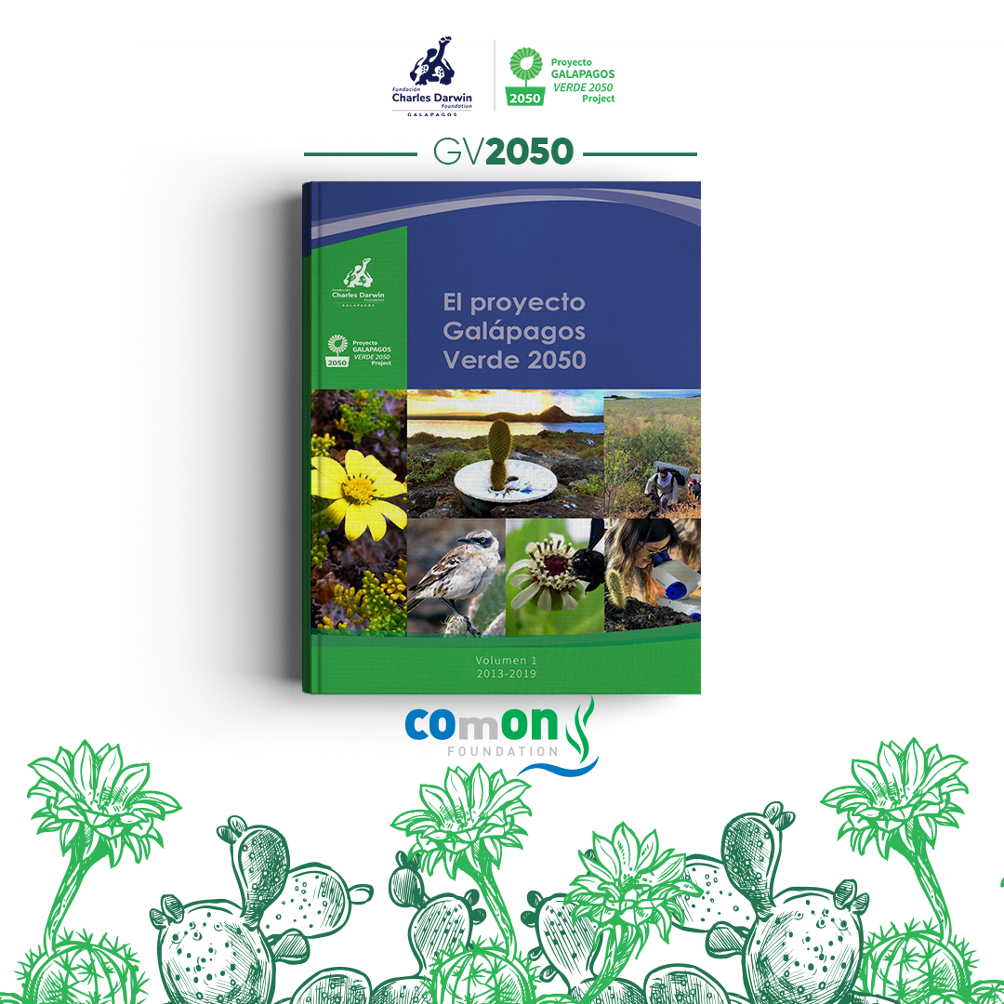
Descargar tríptico sobre el trabajo del GV2050
Descargar artículo científico sobre la efectividad de las tecnologías ahorradoras de agua
Descargar artículo científico sobre el costo-efectividad de las tecnologías ahorradoras de agua
REFERENCIAS
Balseca Moscoso, M. A. (2002). Respuesta de la lagartija de lava (Microlophus albemarlensis) a la erradicación de gatos ferales (Felis catus) en la Isla Baltra, Galápagos [Biblioteca Hernán Malo González]. https://biblioteca.uazuay.edu.ec/buscar/item/66086
Coronel, V. (2000). Germinación de semillas de Opuntia megasperma en la isla Española. III Congreso Ecuatoriano de Botánica, Quito-Ecuador.
De Vries, T., & Black, J. (1983). of Men, Goats & Guava - Problems Caused By Introduced Species in the Galapagos. Noticias de Galápagos, 38, 17–21. http://www.darwinfoundation.org/datazone/media/pdf/38/NG_38_1983_deVries%26Black_Of_men_goats_and_guava.pdf
Estupiñán, S., & Mauchamp, A. (1995). Interacción planta-animal en la dispersión de Opuntia de Galápagos. Charles Darwin Foundation, Puerto Ayora.
Geist, D. J., Mcbirney, A. R., & Duncan, R. (1985). Geology of Santa Fe Island: The oldest Galapagos Volcano. Journal of Volcanology and Geothermal Research, 26, 203–212.
Geist, D., White, W. M., Albarede, F., Harpp, K., Reynolds, R., Blichert-Toft, J., Kurz, M. D., Geist, D., White, W. M., Albarede, F., Harpp, K., Reynolds, R., Blichert-Toft, J., & Kurz, M. D. (2002). Volcanic evolution in the Galápagos: The dissected shield of Volcan Ecuador. Geochemistry Geophysics Geosystems. AN ELECTRONIC JOURNAL OF THE EARTH SCIENCES., 3(10), 1061. https://doi.org/10.1029/2002GC000355
Gibbs, J. (2013). Baltra Island Restoration as an Extraordinary Opportunity to Harness and Showcase Waterboxx Technology. 1–2.
Hicks, D. J., & Mauchamp, A. (2000). Population Structure and Growth Patterns of Opuntia echios var. gigantea along an Elevational Gradient in the Galápagos Islands. Biotropica, 32(2), 235–243. https://doi.org/10.1111/J.1744-7429.2000.TB00466.X
Itow, S. (1992). Altitudinal change in plant endemism, species turnover, and diversity on Isla Santa Cruz, the Galapagos Islands. Pacific Science, 46(2), 251–268.
Jaramillo, P., Jiménez, E., Cueva, P., & Ortiz, J. (2013). Baltra: un reto para la restauración ecológica de ecosistemas áridos. Paper Presented at the Jornadas Ecuatorianas de Biología, Universidad de Santa Elena.
Jaramillo, P., Tapia, W., & Gibbs, J. (2017). Action Plan for the Ecological Restoration of Baltra and Plaza Sur Islands. 2, 1–29.
Kenchington, R. A. (1989). Tourism in the Galápagos Islands: The Dilemma of Conservation. Environmental Conservation, 16(3), 227–232. https://doi.org/10.1017/S0376892900009309
Phillips, R. B., Cooke, B. D., Campbell, K., Carrion, V., Marquez, C., & Snell, H. L. (2005). Eradicating Feral Cats to protect Galapagos Land Iguanas: methods and strategies. Pacific Conservation Biology, 11(4), 257–267. https://doi.org/10.1071/PC050257
Snell, H. M., Stone, P. A., & Snell, H. L. (1996). A summary of geographical characteristics of the Galapagos Islands. Journal of Biogeography, 23(5), 619–624. https://doi.org/10.1111/J.1365-2699.1996.TB00022.X
Sulloway, F. J., & Noonan, K. M. (2015). Opuntia Cactus Loss in the Galapagos Islands, 1957-2014 (Pérdida de cactus Opuntia en las Islas Galápagos, 1957-2014). Puerto Ayora.
Colaboraciones interinstitucionales
Dirección Parque Nacional Galápagos (DPNG), Galápagos Conservancy, Agencia de Regulación y Control de la Bioseguridad y Cuarentena para Galápagos (ABG).
Nuestro donante principal
COmON Fundación
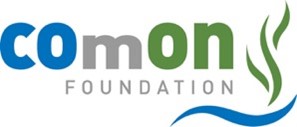
 Donors:
Donors:

Partners:




